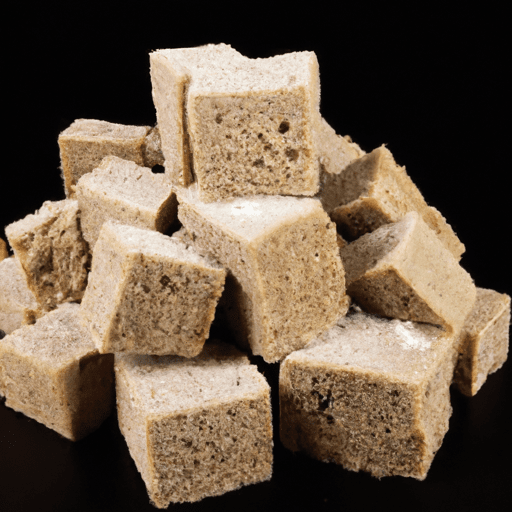Bread Cubes: A Versatile and Nutritious Ingredient
Have you ever wondered what to do with leftover bread? Look no further than bread cubes! This humble yet versatile ingredient has found its way into countless kitchens worldwide. Whether you’re aiming to elevate a salad, create a delicious stuffing, or prepare a crunchy topping, bread cubes are here to save the day.
A Taste and Texture Worth Savoring
Bread cubes offer a delightful blend of textures and flavors. Toasted to perfection, they provide a satisfying crunch that pairs beautifully with a variety of dishes. Depending on the type of bread used, the cubes can add an extra layer of complexity to your recipes. From crusty artisan bread to soft and yielding brioche, there is a bread cube for every occasion.
Countless Culinary Uses
The culinary applications of bread cubes are truly endless. Here are just a few popular uses that bring out the best in this underrated ingredient:
Panzanella: This Tuscan bread salad features juicy tomatoes, crisp cucumbers, and fresh herbs combined with bread cubes. As the dressing soaks into the bread, it becomes a harmonious blend of flavors and textures.
Stuffings and Dressings: Bread cubes form the heart and soul of many legendary stuffings and dressings. Whether you’re preparing a classic Thanksgiving stuffing or a savory meat-free dressing, bread cubes lend a comforting and wholesome element.
Croutons: Nothing elevates a simple salad or a steamy bowl of soup quite like homemade croutons. Sprinkling seasoned bread cubes on top adds a satisfying crunch and depth of flavor.
Bread Pudding: Bread cubes take center stage in this delectable dessert. Soaked in a rich custard and baked to perfection, they transform into a luscious and comforting pudding.
Nutritional Benefits
Bread cubes, particularly those made from whole grain bread, offer a range of nutritional benefits. They are a good source of dietary fiber, which aids digestion and helps you feel fuller for longer. These cubes also provide carbohydrates for energy, as well as essential vitamins and minerals like B vitamins, iron, and magnesium. However, it’s worth noting that the specific nutritional profile can vary depending on the type of bread used.
A Brief History of Bread Cubes
While the exact origin of bread cubes is uncertain, it is believed that they have been around for centuries. Historically, bread cubes were an ingenious way to prevent stale bread from going to waste. As bread was a staple food in many cultures, people found creative ways to repurpose it in various dishes, making the most of every last crumb.
Fun Facts about Bread Cubes
In the United States, bread cubes are sometimes referred to as “bread cubes” or “bread cubes for stuffing.”
Certain bread cubes are specifically formulated to withstand moisture in recipes like stuffing, ensuring they maintain their shape and texture.
The French dish “pain perdu,” also known as “French toast,” traditionally uses bread cubes soaked in a sweet custard before frying.
Chefs often use bread cubes as a substitute for breadcrumbs in recipes, providing a heartier texture and more depth of flavor.
Conclusion
Bread cubes may seem simple, but the possibilities they offer in the realm of cooking are vast. From enhancing salads to creating mouthwatering stuffings, these little cubes of crispiness add a unique touch to any dish. So, the next time you have some leftover bread, don’t toss it away—transform it into delicious bread cubes and let your creativity shine in the kitchen!
Origin: Bread cubes, also known as bread cubes or bread crumbs, have been used in various cuisines for centuries. The exact origin of bread cubes is unclear, but bread itself dates back thousands of years to ancient civilizations such as the Egyptians and Romans.
Common Uses: Bread cubes have numerous culinary applications. They are commonly used as a topping for casseroles, gratins, and macaroni and cheese, providing a crunchy texture and absorbing any excess moisture. Bread cubes also serve as a key ingredient in many stuffings or dressings for poultry, pork, or vegetables. They can be seasoned with herbs and spices, toasted, and used in salads or soups for added texture and flavor.
Nutritional Benefits: Bread cubes contain essential nutrients, including carbohydrates, protein, fiber, vitamins, and minerals. However, the nutritional profile can vary depending on the type of bread used. Whole wheat bread cubes, for example, provide more fiber and nutrients than those made from refined white bread. Bread cubes can be a good source of energy and contribute to a balanced diet when consumed in moderation.
Unique Properties and Historical Significance: Bread cubes have an interesting historical significance. They were used as a way to preserve and make use of stale bread, preventing waste. Before the advent of modern bread-making techniques and storage methods, bread was typically baked in large loaves, which could become hard and less enjoyable to eat after a few days. To prolong its use, bread was sliced or torn into cubes, dried, and then stored.
Throughout history, bread cubes have been an important component of various dishes across different cultures. They were and continue to be a staple ingredient in many traditional recipes, offering a way to make the most of available resources. Today, bread cubes remain popular in a wide range of dishes due to their versatility and ability to add texture and flavor.




Use the share button below if you liked it.
It makes me smile, when I see it.